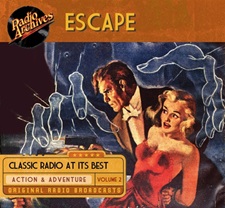
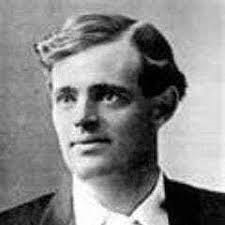 Escape (1947-1954) aired “The Match” on Sunday, May 16, 1948 as the show’s 41st episode. Not surprisingly, we have aired many episodes (35+) of this top-shelf program over the past 15 years, the most recent coming in September of 2023. A spinoff and sister show of the highly popular radio program Suspense (1942-62), Escape produced (according to one source) 251 episodes of which 241 were unique stories, plots, or scripts. Escape concentrated on adventure tales, some with an SF/F theme, though the straight adventure tale set in exotic locales was its meat and potatoes. Escape soon established itself with an even more focused approach to action and exotic adventure, dramatizing literary classics (from such as Rudyard Kipling, Sir Arthur Conan Doyle, Edgar Allan Poe, Ambrose Bierce, Nelson Bond, Ray Bradbury, Eric Ambler, Jack London, Joseph Conrad, and others) while at the same time treating its audience to many brand new tales, a fair number of which have become radio classics. In fact, some of Escape‘s original shows were so well written, acted, and produced they were later reincarnated for episodes of Suspense.
Escape (1947-1954) aired “The Match” on Sunday, May 16, 1948 as the show’s 41st episode. Not surprisingly, we have aired many episodes (35+) of this top-shelf program over the past 15 years, the most recent coming in September of 2023. A spinoff and sister show of the highly popular radio program Suspense (1942-62), Escape produced (according to one source) 251 episodes of which 241 were unique stories, plots, or scripts. Escape concentrated on adventure tales, some with an SF/F theme, though the straight adventure tale set in exotic locales was its meat and potatoes. Escape soon established itself with an even more focused approach to action and exotic adventure, dramatizing literary classics (from such as Rudyard Kipling, Sir Arthur Conan Doyle, Edgar Allan Poe, Ambrose Bierce, Nelson Bond, Ray Bradbury, Eric Ambler, Jack London, Joseph Conrad, and others) while at the same time treating its audience to many brand new tales, a fair number of which have become radio classics. In fact, some of Escape‘s original shows were so well written, acted, and produced they were later reincarnated for episodes of Suspense.
While strangely not consistently supported by its host network CBS, that rarely gave advance notice of upcoming program titles and moved the show to different times and days willy-nilly no fewer than 18 times over its 7-year run, the show found a faithful audience, and continued to produce well-written scripts with many of the finest actors in radio.
“The Match” was given life originally as a 1920 story by James Oliver Curwood (1878-1927, photo top right). Curwood is unfortunately one of those early 20th century authors to have escaped my notice. An embarrassing omission to be sure, but to remedy this egregious oversight I believe that a paragraph from his wikipedia page will, in some small measure and as introduction, serve not only to place him on my personal map, but yours as well: “James Oliver Curwood…was an American action-adventure writer and conservationist. His books were often based on adventures set in the Hudson Bay area, the Yukon or Alaska and ranked among the top-ten best sellers in the United States in the early and mid 1920s, according to Publishers Weekly. At least one hundred and eighty motion pictures have been based on or directly inspired by his novels and short stories; one was produced in three versions from 1919 to 1953. At the time of his death, Curwood was the highest paid (per word) author in the world.” Curwood would leave high school before graduation, and after two years at college he left and became a reporter, then a writer. The rest is history. On a fishing trip to Florida in 1927 he was bitten or stung on the hip (a spider is suspected) and an infection developed over the next few months that eventually worsened to the point of causing his early death.
“The Match” takes us to the wilds of northern Canada in the middle of winter. A Royal Canadian Mounted Police Sergeant by the name of Brokaw is on the trail of one Billy Loring, a murderer who has left his young wife and child in order to escape the clutches of the dedicated mountie, in a chase across a 1,000 mile stretch of blizzard ravaged wilderness. The tension and drama grow ever thicker as the mountie, despite the best efforts of Loring, closes the gap between him and his man. This pure adventure angle is offset by unexpected events that turn the outer adventure and physical hardships that have been building into a compelling psychological test of wills—and character—of the two men, as they—-and we as listeners—eventually find ourselves asking the eternal question about Good and Evil. Are they always to be limned in black and white, or are there indeed shades of gray?
(The linked CD at top includes “The Match” as well as 19 other episodes in a 10-CD set.)
Play Time: 29:28
{This episode airing on a Sunday was perfect timing for the neighborhood gang. There was nothing better to take the sting of having to return to school on a Monday morning than to be able to look forward all day to a visit to the corner newsstand after school the next afternoon. Recalling the sense of danger and drama they felt while listening to “The Match” led them to select the following for more of the same, though from a different perspective. As we have noted while commenting on past episodes here, G-Men Detective (1935-53) was a monthly from its first issue and into early 1940, when it became a bi-monthly due to the waning interest in the exploits of federal agents mostly from at least a decade of over-exposure from many a gangster flick on the silver screen. Until this time the magazine’s title was simply G-Men, but with the switch in title to G-Men Detective the magazine featured more mainstream detective fare. In 1948 it was a bi-monthly, though 1949 saw a reduction to only 5 issues. New Detective (1941-55) began with the mandate of featuring “the NEWest in Crime Fiction,” with an emphasis on the police detective. The middle of 1955 saw the magazine shift focus entirely and become a men’s magazine titled True Adventures. It published no fiction and folded in 1971. New Detective held to its regular bi-monthly schedule in 1948. Private Detective (1937-50) arose a few years after its elder sibling pulp—Spicy Detective—from the same publisher, hit the stands. While patterned after SD, it took the hint from public pressure and toned down the elements of psychopathology in its stories a wee bit and took the edge off of many of its racier covers. It was a steady monthly from 1937-1945 but thereafter its schedule became unpredictable, with but 4 issues in 1948, down from 5 the preceding year.}
[Left: G-Men Detective, 5/48 – Center: New Detective, 5/48 – Right: Private Detective, 5/48]
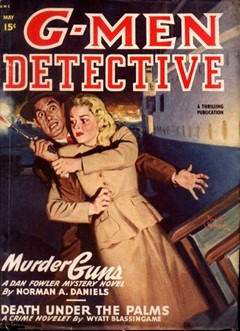
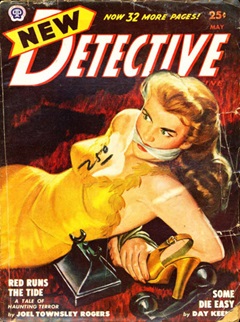
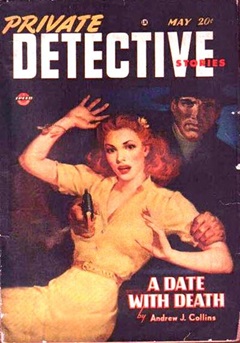
To view the entire list of weekly Old Time Radio episodes at Tangent Online, click here.